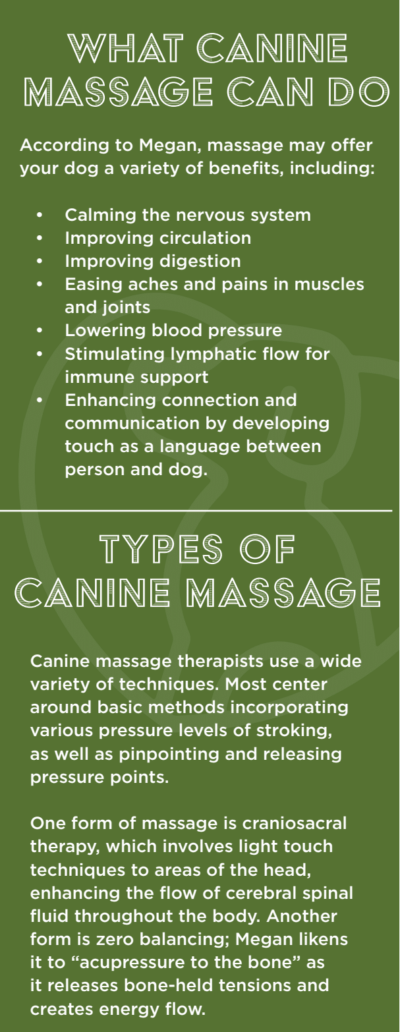
From calming anxiety to easing pain to improving circulation, massage can help improve your dog’s health and well-being.
There’s no substitute for taking your dog to the vet when he’s ailing. However, massage is one example of an alternative practice that can aid with healing and help him feel more comfortable. Canine massage has been used for some time to help dogs cope with a variety of issues, including muscle aches, anxiety, and more.
“While massage is not going to be a ‘cure’ for diagnosed conditions, it can certainly contribute to easing many symptoms, such as pain, stiffness, swelling, or restricted range of motion,” says Megan Ayrault, a certified massage therapist for both people and animals. “Sometimes it’s also used for behavioral issues like anxiety. Massage can be wonderful for supporting the body’s healing process after surgery or an injury. It can also be used to help maintain good health before more serious problems develop.”
SIGNS THAT MASSAGE COULD HELP YOUR DOG
While it’s always important to take your dog to the vet if you notice any changes in his health or behavior, the following signs suggest that a visit to a canine massage specialist may also help: Difficulty with movement, including going up and down stairs, getting in and out of a car, or standing after lying down. Aging or arthritic dogs can definitely benefit. Need for encouragement to keep up with you on walks, or hesitance in wanting to walk. Panting that’s not due to hot weather or exercise. Limping or excessive sensitivity to touch in certain areas.
GETTING YOUR DOG MASSAGED
Taking your dog to a certified massage therapist is the best option, although you can also learn to do some basic massage at home (more on this below). Some holistic and integrative veterinarians offer massage as part of their services, but you can also work with an individual canine massage practitioner.
How often your dog will need a massage depends on her needs. “Professional massage could be done anywhere from two to three times a week, such as after a surgery or injury, to two to three times a year for a young healthy dog whose owner just wants occasional professional assessment for,” says Megan.
MASSAGING YOUR DOG YOURSELF

“For maintenance in between professional sessions, owners can massage their dogs as often as every day for some good benefits, if the dog is receptive to it,” says Megan. A daily massage can be a bonding experience and a great way to become connected to your dog’s overall health. Here are some tips for getting started:
- Ask to watch the massage therapist during sessions with your dog to learn some techniques. You can also find online tutorials for dog massage, or even take courses. For example, the Northwest School of Animal Massage offers both online and in-person courses.
- Use a flat palm and slowly touch your dog all over her body. Take note of how different areas feel to your touch. Pay attention to the skin, muscles, fat and bones. This way, you will be better equipped to notice when something seems amiss.
- To relieve anxiety or stress, rest your palm on top of your dog’s head or neck and make long strokes along the spine, all the way to the tail. Repeat slowly several times. Be sure not to press down on the lower part of the back, as this can stress the spine or hips.
- A gentle massage at the base of the skull and the base of the tail can stimulate relaxation. Remember to make the experience enjoyable for your dog — stop if she recoils, cries out, or seems to be in pain.
- If you notice your dog is more sensitive to touch or feels warmer than usual in certain areas, or if you find any areas of swelling, take her to the veterinarian for an examination. Massage helps you become familiar with your dog’s body, so you can pick up on changes that should be addressed by your vet before they turn into serious problems.
- If your dog has cancer, do not massage him on or around the site of a tumor, since it can increase the spread of malignant cells through the bloodstream.
Whatever your dog’s age, massage is an effective modality to add to his health and wellness regimen. Talk to a holistic or integrative vet about how massage might benefit your canine companion; reach out to a certified canine massage therapist; and learn how to do some foundational massage techniques at home to help ease physical and emotional discomfort and keep your dog happy, relaxed and healthy.

AUTHOR PROFILE
Brian Marshall
Brian Marshall has won numerous writing awards during his 30-plus year career in journalism. The Detroit native and Western Michigan University grad has owned two dachshunds and currently works with a mixed hound in need of obedience training.


